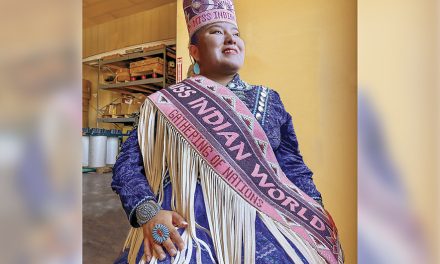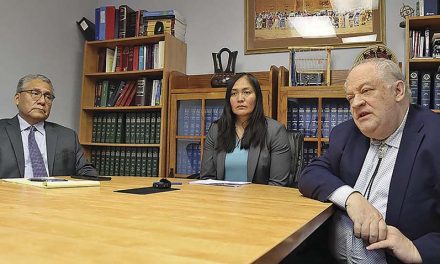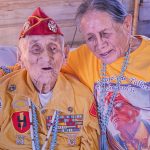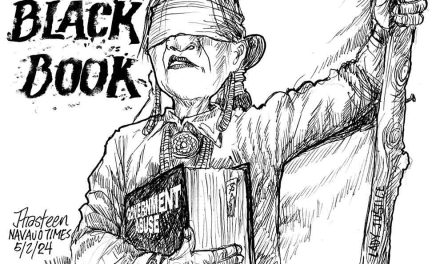
Omicron wave peaking: Transmission rates remain high
WINDOW ROCK
After the exponential growth of Omicron cases in the past month, COVID-19 numbers are beginning to plateau across the United States and on the Navajo Nation.
“We are seeing signs of peaking and a downward trend in cases,” Navajo Nation epidemiologist Del Yazzie said in a town hall on Tuesday.
However, that does not mean people should let their guard down, said President Jonathan Nez.
“We are coming to a flattening of the curve, but we need to continue to wear our masks and follow the protocols,” advised Nez. “Stay close to home. It’s when we let our guard down that we are most vulnerable.”
Yazzie said that despite a slight improvement in the number of cases in the past couple of weeks, the Nation remains in “red” status, with 89 chapters still experiencing high community transmission and the surrounding states of Arizona, Utah, Colorado and New Mexico still reporting high daily case counts.
“We still are seeing a large number of cases here on the Navajo Nation,” said Brian Johnson, Navajo Area Indian Health Service deputy director. “We’re hopeful we’re starting to see a downtick in cases but we have to remain vigilant.”
Johnson said the pandemic has impacted Native Americans more than any other group in the United States with COVID-19 infection rates 3.5 times higher and hospitalizations 4 times more likely than that of non-Hispanic whites.
“The population that we serve is vulnerable to COVID-19,” he said. “We’ve seen that over the many months we’ve been fighting this.”
Of the Navajo population, 64% has been vaccinated, with 48% having received the booster shot.
“We need to get our boosters – everyone,” said Nez. “We don’t know what the future holds. Let’s protect ourselves.”
Johnson also recommended wearing a disposable surgical mask underneath a cloth mask if people do not have N95 masks because cloth masks alone are not sufficient protection with Omicron.
Last week, the federal government launched a program to make 400 million free N95 masks available across the United States through community health centers and local pharmacies.
“Right now is a very critical time in the pandemic,” said Johnson. “We need to make sure to continue to use all of the tools to fight the virus. If we’re going to slow the spread of Omicron, vaccination remains the best public health measure that we can utilize to fight the virus.”
Staffing, resource shortages
The good news is that for the Navajo Area hospital capacity remains below 80%.
“We’re so highly vaccinated that not many people are ending up in the hospital,” said Nez.
Last week, Navajo Area IHS Director Roselyn Tso reported to the Navajo Nation Council that despite the recent “explosion” in cases, relatively fewer patients are coming to the hospital and there has been a decrease in deaths.
“This has a lot to do with vaccines,” she said.
However, they’ve had to closely monitor staffing because health-care workers are also being infected or reinfected by COVID-19.
“We’re not able to fully staff some of our programs now because our staff are testing positive or they’re in isolation,” she said. “Because we’re not able to do everything we normally do, we’re struggling to meet the needs of our patients.”
While Navajo Area IHS hospitals remain very busy, she said, they have not reached the point where they have to turn patients away.
“However, we have also notified our patients that some people might have to wait a little longer for visits or our providers will have to prioritize people that we are servicing on any given day,” said Tso. “That has also forced us to implement crisis standards of care at certain times and certain locations.”
She said they hired 40 contact tracers to follow up on COVID-19 cases, but that is not enough to keep up with case tracking right now.
“Because we have so many cases right now, we do not have the manpower to be able to respond to every positive case we have in the Navajo Area,” she said.
U.S. Department of Defense medical professionals were recently deployed to Shiprock’s Northern Navajo Medical Center and 240 Public Health Service officers have been brought in to augment Navajo Area staff.
However, Tso said Navajo Area IHS sites are still struggling with transfers of patients to facilities for higher levels of care.
Sometimes staff have to call 40 or 50 different hospitals to try to find an open bed, she said, and sometimes the wait to be transferred is two to three days.
“Our job is to find that location for them,” said Tso. “We’ve tried to keep patients closer to home as we work through this process.”
It’s a challenge to maintain supplies and supplemental staffing, including contract nurses, because health-care facilities across the country are competing for the same limited resources, said Tso.
This also applies to testing supplies and personal protective equipment, which are monitored closely.
Tso said Navajo Area IHS is partnering with Navajo Nation chapters to make sure people have access to test kits, which allows people to avoid ER visits.
“Our people want to know if they’re experiencing symptoms – they want to be able to test themselves,” she said.
They have distributed 15,000 test kits in the Navajo Area in the past couple of months, but they are running out of kits as soon as they get them, she said.
“We are hearing though that test kits are going to be harder to come by,” said Tso. “We order as much as we can when we can.”
Tso said Navajo Area IHS is also working to improve access to telemedicine, which also reduces the number of trips to health-care facilities.
Neither the president’s office, Navajo Department of Health Director Jill Jim, who oversees the COVID-19 Health Command Operations Center, responded to a request for information from Navajo Times.
Previous infection protected against Delta
In a White House briefing last week, CDC Director Rochelle Walensky said that although case rates in the U.S. have been higher during the Omicron surge, indicators such as hospital length of stay, ICU admissions, and deaths are lower with Omicron than during previous periods of high COVID-19 transmission.
“And this is likely attributable to two key factors,” said Walensky. “First, many people in our country have some level of immunity from vaccination and boosters or from previous infection. And second, it’s likely that Omicron is less severe than prior variants.”
However, Walensky cautioned that just because Omicron appears to be “milder,” this does not mean that everyone getting sick experiences “mild” symptoms, she said.
Protection from immunity derived from prior COVID-19 infection is something that is being studied internationally.
On Jan. 19, the CDC announced the results of a study conducted in New York and Los Angeles, which found that people who had previously been infected with COVID-19 were better protected against the Delta variant than those who were only vaccinated.
This suggested that “natural immunity” derived from prior infection produced strong protection against Delta.
According to the CDC, before the Delta variant became the dominant variant in June, case rates were higher among people who survived a previous infection than persons who were vaccinated alone.
But by early October, persons who survived a previous infection had lower case rates than persons who were vaccinated alone.
Across the entire study period, persons with vaccine and infection-derived immunity also had much lower rates of hospitalization compared with those in unvaccinated persons.
“Between May and November 2021, people who were unvaccinated and did not have a prior COVID-19 infection remained at the highest risk of infection and hospitalization, while those who were previously infected, both with or without prior vaccination, had the greatest protection,” stated the CDC.
This timing of the study also coincided with vaccine protection starting to wane and the announcement that booster shots were needed to fortify vaccine immunity, so the study is imperfect due to these variables.
“Importantly, infection-derived protection was higher after the Delta variant became predominant, a time when vaccine-induced immunity for many persons declined because of immune evasion and immunologic waning,” states the study.
The analysis also did not include information on the severity of initial infection and does not reflect the risks of morbidity and mortality associated with infection.
The CDC says further studies are still needed to establish duration of protection from previous infection by variant type, including for the Omicron variant, and that vaccination remains the “safest and primary strategy” to prevent SARS-CoV-2 infection, associated complications, and onward transmission.








 Highway 264,
Highway 264, I-40, WB @ Winslow
I-40, WB @ Winslow